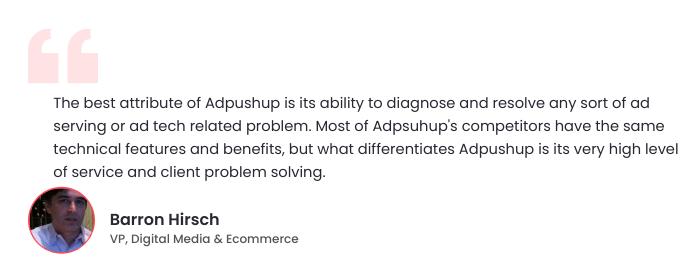Ads and user experience aren’t the frenemies they are made out to be. Publishers need both to survive and thrive. It’s your ability to empathise with user needs that holds the key to strike the right balance.
Every online guide on optimizing ad revenue invariably refers to ads and user experience as frenemies (or something to that effect).
Some even go to the extent of calling ads “necessary evil”; but are they really? Ads generate revenue for the sites, how can they be evil?
Before jumping to the conclusion, let’s go back to the basics – basics of communications and human psychology, not just digital media.
Humans put in the effort when a tangible benefit is in view.
It can be anything, ranging from a financial reward to a sense of accomplishment. From typing in a search query, skimming through search results, clicking on your link, waiting for the site to load and finally consuming content – an average visitor puts in significant effort before reaching your site.
This user effort needs to be rewarded by providing them the best website experience.
If your site fails to fulfil the need, the user goes back and searches for the same query again. If this bounce happens consistently, it adversely impacts your SEO, leading to lesser traffic and subsequently lower revenues.
Therefore, in this blog post, we will try to understand the art and science of balancing ads and UX.
Ways to Balance Ad Revenue and User Experience
Websites can deliver good user experience without jeopardising their ad revenue in the long term. Here are three things that can help publishers improve the ad quality for better user experience.
Engage with context: Fulfil user’s purpose of visiting your site
Keep it light: Do not overload your site with ads
Optimize: Test what works best and keep optimizing
- Engage With Context
First up, as a rule, always fulfil the purpose of the visitor and only then offer them more of what they like.
Say, if you post video game reviews, you may share some content on the latest gaming console after the user consumes the info related to games. That’s contextualization for you.
Now, look at ads as another piece of content. Are your ads fulfilling the needs/wants of your visitor?
If you believe cookies don’t lie, think again.
Any additional information you put out on your page needs to supplement the content you have published. Unrelated content doesn’t help. For example, bombarding a visitor to your gaming site with real estate ads makes little sense because:
One, it’s highly unlikely she’s come looking for real estate reviews on your website. You are simply annoying her by showing ads based on her visits to other sites.
Two, she may not be inclined to buy it. Not that gamers do not buy real estate, but there is a perceptible incongruity in the real estate ads displayed and user mindset while visiting a gaming site.
When you deliver contextually relevant ads, you drive better engagement. Consequently, your click-through rates go up and so do conversions. Tempting as it may be to deliver all ads in all formats available, you risk putting your user through a terribly unfulfilling experience. For the sake of instant high revenues, you wouldn’t want to kill the goose laying golden eggs, would you?
Also Read: What is Contextual Advertising? How Does it Work?
Admittedly, as a publisher you have little control over personalization of ads, but you definitely can limit the out-of-context/irrelevant ads that appear on your website. So, contextualization is the way to go! - Keep it Light
“What’s the ideal number of ads on a page?”, is one of the most popular queries among newbie publishers. How much is too much depends on a whole lot of factors. Even two ads that load a few seconds late, forcing the content to abruptly shift down, are too much at times.
In case of sticky ads, pop-unders, ads that play with audio – even one is too much for a page at times.
Having said that, a one-size-fits-all approach does not exist. Several large publishers choose the number and format depending on what works for them. Without access to large teams and resources, smaller publishers struggle to find the right balance.
Most publishers would fall in either of the following two categories:
Long term value seekers – who believe that content is sacrosanct and value needs to be delivered to the visitor seamlessly. Ads, to you, are obstructive.
Short term thinkers – who advocate milking great content with as many ads as possible.
Both approaches court extremity and are rife with risk of not making money. Publishing too many or too few ads equally hurt your revenue prospects. There isn’t a thumb rule on the ideal number of ads that a page may carry. But overloading a site with ads significantly upsets user experience. Finding balance is the key.
Also Read: What is the 30% Ad Density Rule? And Why Should You Care?
After the number of ad units on a page, think about the loading time they are taking. Depending on your codebase, the ad unit you place adds to the loading speed your site.
You might be familiar with the 3 second rule glorified by Google that says “The probability of bounce increases 32% as page load time goes from 1 second to 3 seconds.”
You wouldn’t want to lose your visitors.
No, right? Then, Publisher Ads Audits for Lighthouse is a good place to start. Run an audit to learn more about your ad loading speed.
When you know whether you have slow ad loading issues, you can deploy solutions to ensure fast ad serving. One of such solutions can be lazy loading ads, that loads only when the user is ready/about to view the ads rather than fetching ads during initial page load.
Notably, it is not just the number of ads that amount to overloading or ad fatigue. The type of ads, viewability, placement, loading time, and just about everything that alters the landscape of the page can lead to poor user experience. - Test and Optimize
Ads, more often than not, are the only elements of your website that help you make money. Treating it distinct from your website content, or beyond your sphere of control/accountability isn’t the right way to look at it. To make money, you need to invest time and effort in optimizing ads as you would for content.
With multiple variables affecting ad revenues, it is difficult to carry out on all parameters in one go. Hence, it is advisable to start with ad placements, as it is least likely to affect user experience. You may choose to run A/B or multivariate testing to arrive at the best layouts.
You also need to develop a deep understanding of how people interact with your content and ads to optimize it for better revenues. A heat map tool will help you understand how users move about on your site, where they click and extent of the scroll – all in real-time. If you haven’t installed it already, do it now.
Pay special attention to how users interact across geographies, time zones, and other demographic segments. Such insights could prove invaluable to drive better engagement through more contextual and personalized ad content.
Focus on creating a better user experience to optimize your ad revenues. Continuous and consistent testing will ensure you stay ahead of the curve by adapting to changing user behaviour.
Best Practices to improve User Experience with Ads
To build a better user experience and negate the adverse impact of ads, here’s a laundry list of best practices to pull off the perfect balancing act:
- Avoid anything that blocks content
- Pop-ups, large sticky ads, full-screen scroll-over ads block content from the user’s view. Remember the user came to your site for content in the first place; by blocking it you are effectively taking away the reason for them to continue on your site.
- Paywalls at the first visit serve little purpose. Few users are likely to pay for content without being assured of the quality. Therefore, first allow them to be familiarized with the content – a couple of free articles might help you convince them
- Do not hoodwink the user or the marketer/ad network
- Do not force visitors to view the ad against their will
- Avoid expandable ads that refuse to close or result in accidental clicks
- Steer clear of prestitial ads with a countdown that makes users wait until the ad is over – which, frankly, annoy most users and do not help the brands either
- Remember pop-unders do little to build credibility and reputation
- Keep the experience smooth and enjoyable
- Choose ad types that are less intrusive in nature. Better Ads Standards has done the job of listing down all the intrusive ads by surveying internet users.
- Try native ads as they blend with the site content that doesn’t look or feel like ads.
- Auto-playing video ads with sound are most annoying when they play unexpectedly and cause a disturbance in the user’s environment too
- Flashy animated ads begging for attention could be a huge turn-off for users browsing in the dark. So, avoid.
Final Thoughts
Ads aren’t a “necessary evil”. They are, perhaps, the only element on the website that make publishers money. Successful monetization depends on value the publisher delivers through the right combination of content and ads.
There exists no perfect solution or magic formula to optimize ad revenues. Everything boils down to providing a great user experience and driving engagement by providing value. It can be achieved through personalized and contextual ads.
Blanket bombing and forcing views that ruin user experience help neither the marketers nor the publishers. Continuous testing and optimization are all but inevitable to achieve and maintain balance between user experience and ads.

FAQs
The most effective way to maximize revenue and UX is to provide personalized ad combinations for each user.
User experience refers to how easy or pleasing it is to use a product, such as a website or computer application.
Revenue models based on advertising involve creating ads for specific websites, services, apps, or other products. The most popular way to get ads is through Google’s AdSense.

Shubham is a digital marketer with rich experience working in the advertisement technology industry. He has vast experience in the programmatic industry, driving business strategy and scaling functions including but not limited to growth and marketing, Operations, process optimization, and Sales.







